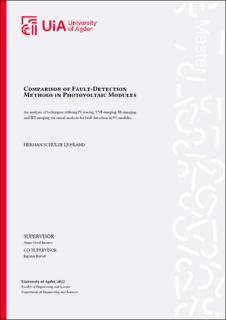| dc.description.abstract | This Master's thesis is written to fulfil the graduation requirements of the Master's Programme in Renewable Energy Engineering during the spring of 2022, and is based on previous work at the University of Agder (UiA).
The thesis compares the five different PV-module fault-detection techniques of UVF-, indoor/outdoor IRT-, EL-imaging, and IV-tracing, based on the current literature and the experiments performed on five select PV-modules. The faults of the five PV-modules are defined by visual inspection of the experiment results, and an order of when to use each of the five fault-detection techniques is presented.
It was found that the faults-types detectable by these methods are cell-cracks, isolated cell-areas, circuit issues, resistance issues, hot-spots, defective bypass-diode, potential induced degradation, and optical degradation. The five tested PV-modules, available at UiA, were found to be suffering from cell-cracks of varying severity from negligible to causing areas of cells to be isolated from the circuit, hot-spots, high internal cell-resistance, and faults caused by production-issues or mechanical overloading. One should use IRT-imaging, UVF-imaging, IV-tracing, and EL-imaging, in order, to perform fault-detection on modules in a PV-farm. This order is based on the technique's fault-detection efficacy, and how intrusive it is to the normal operation of the PV-farm. | |
